Navajo Cornbread isn’t just a side dish—it’s a slice of American history, a comfort food, and a tradition you can bring right into your own kitchen. If you’ve ever wanted to experience a bread that blends Native American heritage with rich, hearty flavors, this is the recipe you need to try. More than a basic cornbread, Navajo Cornbread is rooted in the stories, gatherings, and celebrations of generations.
At Recipes Tasteful, we believe every recipe should tell a story. That’s why sharing Navajo Cornbread isn’t only about ingredients and instructions—it’s about honoring the past while making something truly delicious for today’s table. On our About page, you can discover how we’re dedicated to preserving authentic recipes, just like this one, and bringing families together with the taste of tradition.
Whether you’re a longtime fan of classic American cornbread or looking to try something new, this guide covers everything: the rich Native roots of Navajo Cornbread, its traditional ingredients, expert baking tips, and creative serving ideas. We’ll even answer the most popular cornbread questions and help you make your own perfect batch at home.
Don’t miss our story—Learn more about Recipes Tasteful and our passion for tradition before you bake your first batch!
Table of Contents
Table of Contents
The History and Heritage of Navajo Cornbread
The Roots of Navajo Cornbread in Native American Cuisine
The history of Navajo Cornbread stretches back centuries, rooted deeply in the culinary traditions of the Navajo Nation and the wider Native American community. Corn, also known as maize, was a fundamental crop for indigenous peoples across North America, and it quickly became the cornerstone of their diets. Not only did corn provide sustenance, but it also played a crucial role in spiritual and cultural rituals.
Navajo Cornbread is a product of this long history—blending ancient agricultural practices with a love for hearty, nourishing bread. Early versions of this bread relied on ground cornmeal, which was combined with natural ingredients gathered from the land. Unlike commercial breads that rely on yeast for leavening, traditional Navajo cornbread often uses baking powder or sometimes even relies on the natural rise from beaten eggs. This approach gives the bread its signature dense but tender texture and sets it apart from other types of American cornbread.
Cultural Significance of Cornbread Among the Navajo and Other Tribes
For the Navajo, and many other indigenous communities, cornbread is more than just food—it’s a symbol of resilience, adaptability, and connection to the land. Every batch of Navajo Cornbread carries with it a sense of history and community, often served during family gatherings, celebrations, and ceremonies. The bread’s simplicity and adaptability meant it could be made in almost any setting, from open fires on the plains to modern ovens in home kitchens.
Across the Southwest and beyond, cornbread recipes vary by region and tribe, but the core traditions remain the same: use what’s available, waste nothing, and share the results with those you love. While Southern cornbread might include more sugar or dairy, and Northern versions lean toward savory, Navajo Cornbread reflects a balance of flavors—hearty, gently sweet, and satisfying.
In fact, the enduring popularity of cornbread in American cuisine can be traced directly to these indigenous origins. Today, baking Navajo Cornbread is more than just following a recipe—it’s a way to honor the past and bring generations together, one delicious loaf at a time.
Looking for inspiration? Try our Classic Skillet Cornbread for another take on this cherished tradition.
Print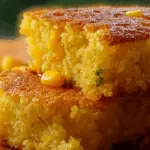
Is Delicious Navajo Cornbread the Most Authentic American Cornbread Recipe?
- Total Time: 40 minutes
- Yield: 9 servings
- Diet: Vegetarian
Description
Navajo Cornbread is a flavorful, slightly sweet cornbread that’s soft on the inside with a slightly crispy crust. Traditionally served with chili, stew, or as a side dish, this cornbread is a staple in Native American cuisine and brings a comforting, hearty touch to any meal.
Ingredients
- 1 cup cornmeal
- 1 cup all-purpose flour
- 1/4 cup granulated sugar
- 1 tablespoon baking powder
- 1/2 teaspoon salt
- 1 cup milk
- 2 large eggs
- 1/4 cup unsalted butter, melted
- 1/4 cup vegetable oil
- 1/2 cup sour cream (optional for extra moisture)
- 1 tablespoon honey (optional, for added sweetness)
Instructions
- Preheat the oven: Preheat your oven to 375°F (190°C). Grease a 9×9-inch baking dish or a cast-iron skillet with butter or cooking spray.
- Mix the dry ingredients: In a large bowl, combine the cornmeal, flour, sugar, baking powder, and salt. Stir to combine.
- Mix the wet ingredients: In a separate bowl, whisk together the milk, eggs, melted butter, vegetable oil, sour cream (if using), and honey (if using).
- Combine wet and dry ingredients: Pour the wet ingredients into the dry ingredients and stir just until combined. Be careful not to overmix.
- Pour the batter: Pour the batter into the prepared baking dish or skillet and spread it out evenly.
- Bake: Bake in the preheated oven for 25-30 minutes, or until the top is golden brown and a toothpick inserted into the center comes out clean.
- Cool and serve: Allow the cornbread to cool for a few minutes before cutting into squares. Serve warm with butter or alongside chili, stew, or soup.
Notes
- You can add 1/2 cup of shredded cheese, chopped green chilies, or even diced jalapeños for extra flavor and a little heat.
- If you prefer a sweeter cornbread, you can increase the sugar to 1/2 cup.
- This cornbread can also be made in a cast-iron skillet for a more authentic and crispy crust.
- Prep Time: 10 minutes
- Cook Time: 30 minutes
- Category: Side Dish
- Method: Baked
- Cuisine: Native American
Nutrition
- Serving Size: 1 square
- Calories: 220 kcal
- Sugar: 10 g
- Sodium: 300 mg
- Fat: 10 g
- Saturated Fat: 5 g
- Unsaturated Fat: 4 g
- Trans Fat: 0 g
- Carbohydrates: 30 g
- Fiber: 2 g
- Protein: 4 g
- Cholesterol: 50 mg
Traditional Navajo Cornbread Recipe Ingredients and Their Meanings
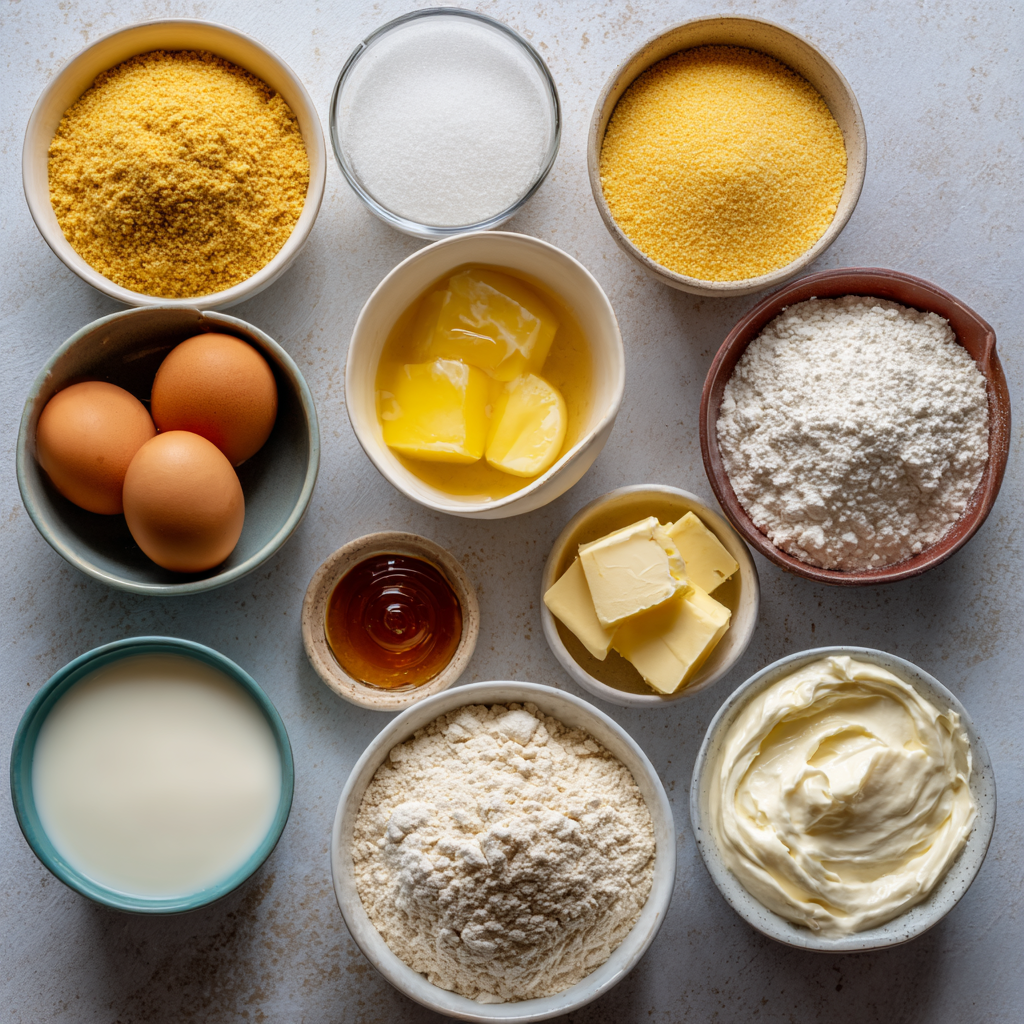
Core Ingredients: Cornmeal, Flour, and More
At the heart of every authentic Navajo Cornbread recipe are a few simple yet powerful ingredients. The cornerstone is, of course, cornmeal—typically stone-ground for a hearty, slightly coarse texture that sets Navajo cornbread apart from other styles. Yellow cornmeal is most common, but white cornmeal works just as well if that’s what you have on hand.
Another key ingredient is all-purpose flour, which gives the bread a lighter crumb and helps balance out the coarseness of cornmeal. Sugar, though used sparingly, adds a gentle sweetness that never overpowers. Some traditional Navajo cooks skip the sugar altogether, letting the natural flavors of corn shine, while others prefer a subtle hint to complement savory dishes.
Baking powder ensures a fluffy, tender loaf, while salt brings out the nuanced flavors. The wet ingredients—milk, eggs, melted butter, and oil—combine to create a rich, moist crumb. For extra moisture and tang, sour cream can be added, though it’s optional. Finally, a touch of honey (also optional) nods to the bread’s roots in natural, whole ingredients.
Here’s a quick look at what you’ll need for classic Navajo Cornbread:
| Ingredient | Purpose |
|---|---|
| Cornmeal | Adds texture & traditional flavor |
| All-purpose flour | Balances texture |
| Sugar | Adds light sweetness |
| Baking powder | Lifts and lightens the bread |
| Salt | Enhances flavor |
| Milk | Moistens the batter |
| Eggs | Binds & adds richness |
| Melted butter | Deepens flavor |
| Vegetable oil | Ensures moistness |
| Sour cream | Optional—extra moisture & tang |
| Honey | Optional—natural sweetness |
Looking for inspiration? Try our Amish Apple Fritter Bread for another classic, old-fashioned treat.
Ingredient Substitutions and Regional Variations
While this lineup forms the backbone of a traditional Navajo cornbread recipe, don’t be afraid to make it your own. Some bakers use buttermilk instead of regular milk for a tangier taste. Others add blue cornmeal—a cherished ingredient in Southwestern cooking—if they can find it.
In certain Navajo households, the bread is kept entirely savory, with no sugar or honey at all. Sometimes, a handful of roasted green chiles or sun-dried tomatoes gets mixed in for a modern Southwestern spin. If you’re looking for a gluten-free version, try swapping the all-purpose flour for a 1-to-1 gluten-free blend.
The beauty of Navajo Cornbread lies in its adaptability and connection to the land. Every family, every cook, and every region has their own special twist. What remains constant is the bread’s ability to bring warmth and togetherness to any table.
Don’t miss our Caramel Apple Bread for a sweet bread you can serve alongside your next meal.
Step-by-Step Guide to Making Navajo Cornbread
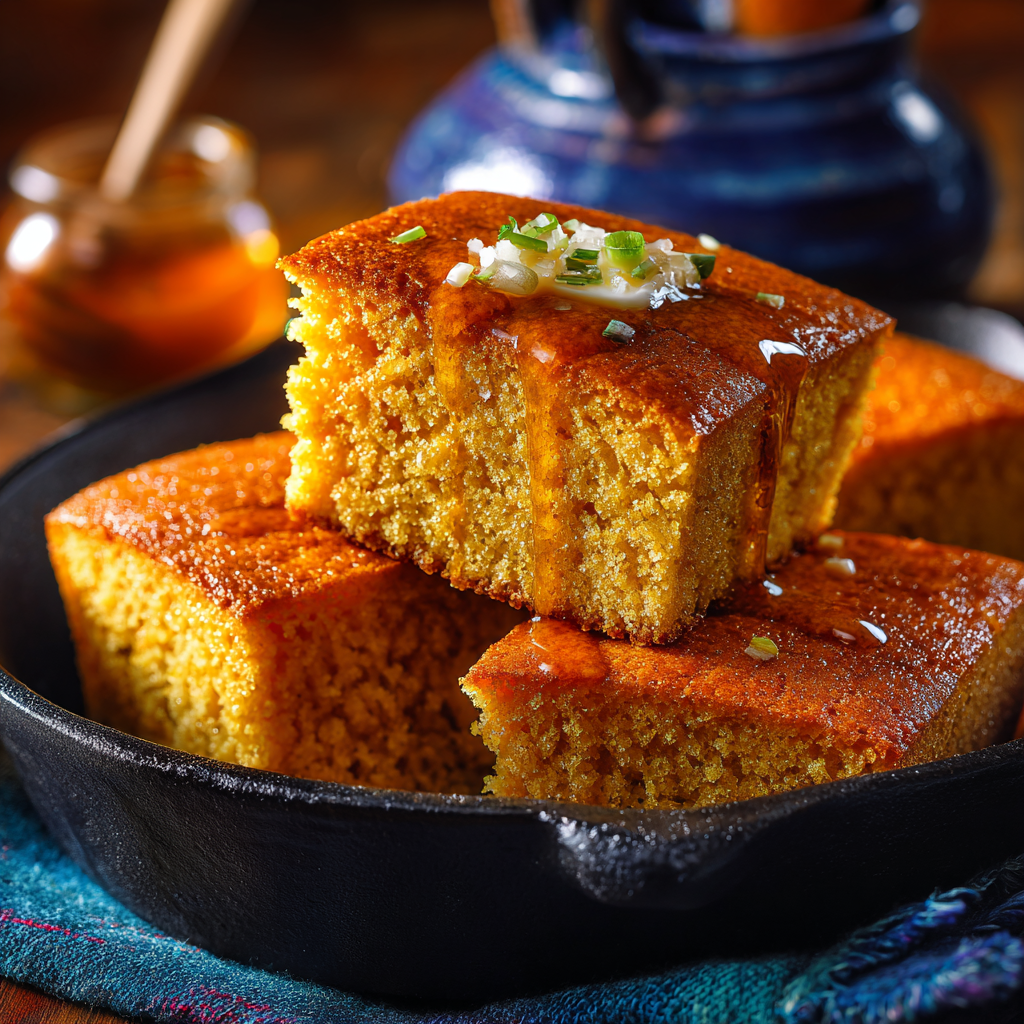
Mixing and Combining the Ingredients
Now that you know what goes into an authentic Navajo Cornbread recipe, let’s break down how to bring those ingredients together. Start by preheating your oven to 375°F (190°C). A cast iron skillet gives your cornbread a rustic edge, but a well-greased 9×9-inch baking dish works perfectly, too.
Begin by mixing your dry ingredients. In a large bowl, combine the cornmeal, all-purpose flour, granulated sugar, baking powder, and salt. Stir everything well—this helps ensure an even crumb throughout your bread. For the best results, make sure your cornmeal and flour are fresh; this can make all the difference in both flavor and texture.
In a separate bowl, whisk together your wet ingredients: milk, eggs, melted butter, vegetable oil, and if you’re adding them, sour cream and honey. Mixing the wet ingredients separately prevents overworking the batter later, keeping your Navajo Cornbread light and moist. When everything is smooth, pour the wet mixture into the dry. Use a gentle hand and stir just until combined; overmixing will make your bread tough.
Baking Tips: Skillet vs. Baking Dish
Here’s where your bread truly takes shape. Pour the batter into your prepared skillet or baking dish, spreading it evenly. If you’re aiming for that signature crispy edge, a cast iron skillet is the way to go. Either way, slide your dish into the oven and bake for 25–30 minutes. The top should turn golden brown, and a toothpick inserted into the center will come out clean when it’s ready.
Resist the urge to cut in right away—letting your Navajo Cornbread cool for a few minutes helps it firm up, making for cleaner slices and richer flavor. Serve it warm with a pat of butter, a drizzle of honey, or as the perfect companion to chili, stew, or soup.
If you’re looking to impress at your next gathering, don’t miss our Mini Pimento Cheese Balls as a unique side, or try pairing your bread with hearty dishes like Greek Spicy Feta Dip for a flavorful contrast.
Why Navajo Cornbread Is Different from Southern Cornbread
Flavor Profiles and Texture Comparisons
It’s easy to assume all cornbread is the same, but the moment you taste Navajo Cornbread, you’ll notice some real differences compared to the more familiar Southern varieties. Southern cornbread, especially the kind baked in the Deep South, is often savory, crumbly, and made with little or no sugar. Sometimes, it’s cooked in bacon fat and always aims for a crisp, crunchy edge thanks to a sizzling-hot cast iron skillet.
Navajo Cornbread, on the other hand, blends a hearty corn flavor with a denser, more cake-like texture. While it can be made sweet or savory, most traditional Navajo recipes include just enough sugar or honey to balance the earthy taste of the cornmeal—never overpowering, always complementing. The addition of flour and sometimes sour cream gives this bread a tender bite, and using vegetable oil alongside butter ensures lasting moisture.
There’s also a rustic, wholesome feel to Navajo Cornbread. It’s designed to hold up to robust dishes, from spicy chili to smoky stews, without falling apart. Even reheated the next day, it retains its texture and satisfying bite.
Serving Traditions and Typical Pairings
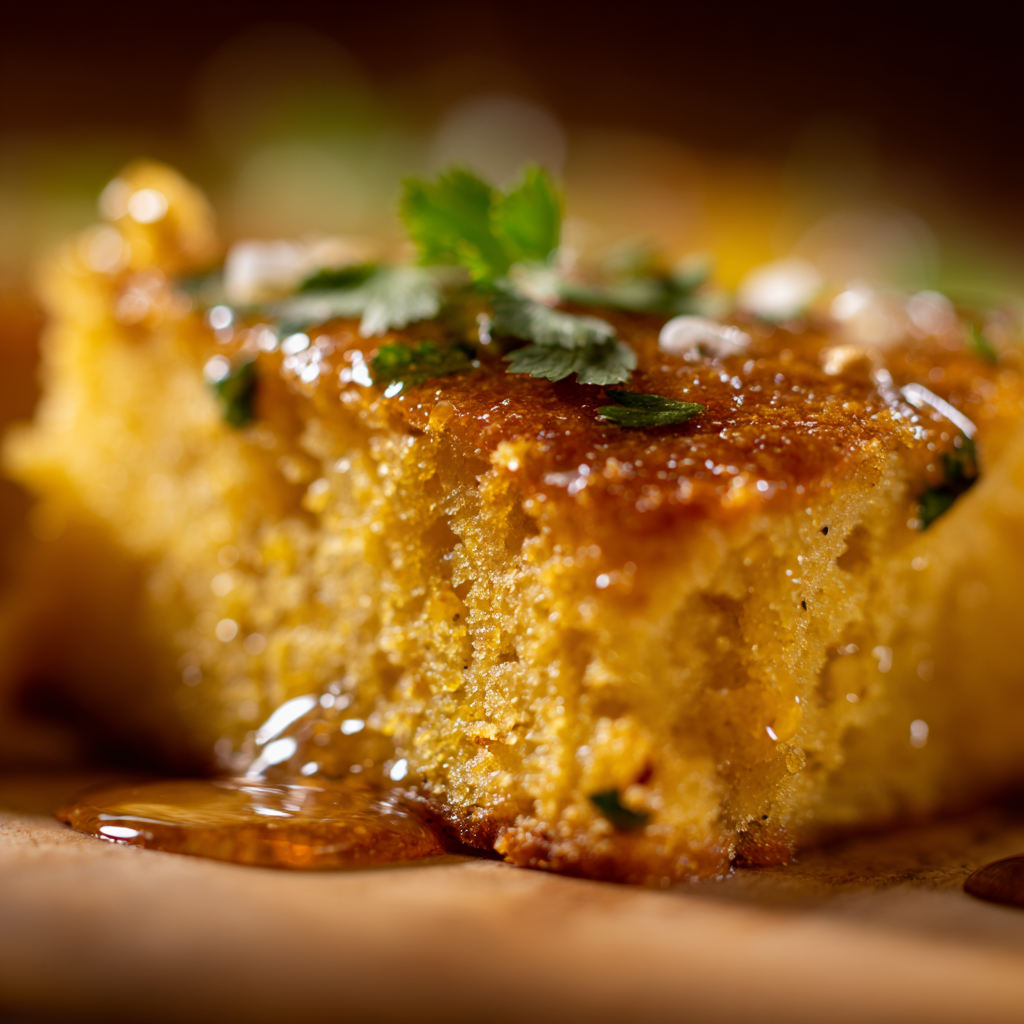
Serving Navajo Cornbread isn’t just about taste—it’s about tradition and hospitality. In many Navajo homes, cornbread is a centerpiece for both daily meals and special celebrations. It’s often served with a spread of butter or honey, but just as frequently, you’ll find it alongside classic Native stews, beans, and grilled meats.
Southern cornbread, by contrast, is famous for being served with collard greens, fried chicken, or black-eyed peas. While both styles have a loyal following, Navajo Cornbread’s adaptability makes it a star for nearly any meal—breakfast, lunch, or dinner. It’s even sturdy enough for lunchboxes or picnic baskets.
Don’t miss our Apple Cranberry Coleslaw as a refreshing, colorful side that pairs perfectly with a warm slice of Navajo Cornbread.
Exploring Other Traditional American Cornbread Recipes
Comparing Navajo, Southern, and Other Native Cornbread Styles
When it comes to American cornbread, every region has its favorite version—and each tells a story. Navajo Cornbread is unique for its blend of heritage and simplicity, but it’s just one star in a constellation of classic American breads.
Southern cornbread is famously crumbly, often made with white cornmeal, and sometimes cooked in bacon fat. It’s usually unsweetened, relying on the bold flavors of the corn itself and the richness of the pan. In contrast, Navajo Cornbread brings a bit of sweetness (thanks to sugar or honey), a softer crumb, and often includes a mix of both cornmeal and flour for perfect balance.
Other Native American communities have their own historic breads, too. For example, Hopi piki bread is thin and rolled, while Cherokee bean bread blends cornmeal with mashed beans for a denser loaf. Even in New England, cornbread has a twist—often sweetened with molasses and baked as a pudding-like dessert called Indian pudding.
Unique Cornbread Recipes from Around the USA
Curious cooks often like to experiment, and there’s no shortage of creative cornbread recipes out there. Some versions incorporate jalapeños and cheddar for a Southwestern kick, while others add blueberries or cranberries for a breakfast-friendly treat. Traditional American Navajo cornbread recipes sometimes get a modern boost from add-ins like green chiles, diced peppers, or even crumbled sausage for a heartier bread.
With every region and family boasting a secret ingredient or method, the beauty of cornbread lies in its versatility. You can keep it simple and rustic, as the Navajo do, or dress it up to suit your taste buds and the season.
Check out our Classic Skillet Cornbread for another traditional take, or discover great ideas like Amish Apple Fritter Bread if you’re in the mood for something sweet and nostalgic.
Expert Tips for the Perfect Traditional Navajo Cornbread
Secrets for a Moist, Fluffy Loaf
Making Navajo Cornbread that’s moist and tender isn’t just about following a recipe—it’s about a few smart techniques that can make every bite memorable. First, always use fresh cornmeal and flour. Stale dry ingredients lead to flat, dull bread. Next, don’t skip the fat! Both melted butter and vegetable oil are key for a moist crumb that stays fresh longer. If you want an extra-soft texture, fold in a half cup of sour cream or even plain yogurt—this not only boosts moisture but also adds a gentle tang that complements the corn flavor.
Another secret is not to overmix the batter. Stir everything just until combined. A few lumps are fine and actually help keep the bread tender, not tough. For a richer taste, drizzle a tablespoon of honey over the top before baking. You’ll get a subtle caramelized crust that’s hard to resist.
Baking in a cast iron skillet brings authentic, crispy edges, but if you don’t have one, any heavy baking dish will work. Always let your cornbread cool for a few minutes before slicing, so the crumb can set and the flavor can develop fully.
Troubleshooting Common Issues
Even experienced bakers can run into trouble now and then. If your Navajo Cornbread turns out dry, check your oven temperature—too hot, and the bread will bake too fast, drying out the center. Adding just a bit more milk or sour cream next time can help. If your loaf is too crumbly, it may need more flour or an extra egg for structure.
Sometimes, cornbread sinks in the middle. That usually means it was underbaked or mixed too much. Always test with a toothpick near the center before taking it out of the oven. If it comes out clean, you’re good to go.
For extra flair, try mixing in roasted green chiles, shredded cheese, or even sun-dried tomatoes. These not only boost flavor but keep your traditional Navajo cornbread recipe feeling fresh and exciting.
Don’t miss our Caramel Apple Bread for another foolproof bread that’s packed with moisture and flavor.
The Role of Cornbread in Modern American Cuisine
Navajo Cornbread at the Table Today
In today’s kitchens, Navajo Cornbread has found its way into a whole new world of American cooking. No longer reserved just for tradition or special occasions, it’s now enjoyed as a versatile side dish, a hearty snack, or even the main event. Busy families appreciate its quick prep, budget-friendly ingredients, and the way it transforms simple meals into something special. Navajo Cornbread fits right in at backyard barbecues, holiday feasts, and weeknight dinners alike.
Modern chefs and home cooks alike are rediscovering the rich heritage of this bread while giving it contemporary flair. For example, some add roasted corn or herbs for extra depth, while others serve it with fresh salsas, whipped honey butter, or spicy chili. The rustic, satisfying nature of Navajo Cornbread means it pairs beautifully with a wide range of flavors and dishes.
Creative Ways to Serve and Enjoy
Navajo Cornbread’s adaptability makes it a star at any meal. Try slicing it thick and using it as the base for a savory breakfast stack—top with eggs, beans, and salsa for a Southwestern-inspired morning. Crumble it into salads for texture, or cube it and toast for crunchy homemade croutons.
For a unique appetizer, cut cooled Navajo Cornbread into bite-sized squares and serve with dips like Greek Spicy Feta Dip or classic guacamole. Don’t forget, leftovers reheat well—just warm in the oven and enjoy as a snack or quick lunch.
Looking for inspiration? Try making our Mini Pimento Cheese Balls for a perfect party pairing, or serve Navajo Cornbread with our Apple Cranberry Coleslaw for a colorful, balanced plate.
Conclusion and Final Thoughts on Navajo Cornbread
Navajo Cornbread is more than just a recipe—it’s a living tradition that brings together heritage, flavor, and family. From its ancient roots in Native American cuisine to its place on modern American tables, Navajo Cornbread bridges generations and cultures. With just a handful of simple ingredients, you can bake a bread that tells a story, comforts the soul, and satisfies every craving.
Whether you enjoy it with butter and honey, alongside a hearty chili, or as a base for inventive meals, this traditional American Navajo cornbread recipe stands out for its hearty texture, gentle sweetness, and adaptability. By following the steps, tips, and variations shared here, you’ll make a loaf that’s not only delicious but meaningful—a tribute to the resilience and creativity of the Navajo people.
Don’t stop at cornbread! Check out Classic Skillet Cornbread for another authentic take, and discover great ideas like Mini Pimento Cheese Balls or Apple Cranberry Coleslaw for your next meal.
If you’re passionate about discovering the heart and history of food, you’ll love what else we’re baking. Don’t miss our story and values on the About page—because at Recipes Tasteful, every dish connects you to something bigger.
FAQs about Navajo Cornbread
Is cornbread Native American?
Absolutely—cornbread has deep roots in Native American cuisine, with recipes dating back centuries before European settlers arrived in North America. Navajo Cornbread is just one example of how indigenous communities, like the Navajo Nation, have transformed cornmeal into nourishing, flavorful bread. Native American cornbread recipes are some of the oldest in the Americas, making this bread a true part of American history.
What are the two types of cornbread?
Generally, there are two primary types of cornbread: Northern and Southern. Southern cornbread is typically savory, uses little or no sugar, and is often baked in a cast iron skillet for a crisp crust. Northern cornbread, on the other hand, tends to be sweeter and softer. Navajo Cornbread is unique—it often finds a middle ground, offering both a gentle sweetness and a rustic, hearty texture. Traditional Navajo and other Native American breads also stand apart due to their use of simple, wholesome ingredients and adaptability to what’s available locally.
What are the 4 ingredients in cornbread?
At its most basic, a traditional Navajo cornbread recipe relies on four essential ingredients:
Cornmeal
Flour
Baking powder
Milk
From there, many recipes add eggs, fat (like butter or oil), and a touch of sweetener for flavor and richness. While different regions and families might customize the recipe, these four ingredients are the foundation of classic American and Native American cornbread alike.
What is the secret to making good cornbread?
The real secret? Don’t overmix! Stir your batter just until the dry and wet ingredients are combined—overworking leads to a tough loaf. Using both butter and oil creates a moist crumb, and adding sour cream or yogurt can make your Navajo Cornbread even more tender. Baking in a cast iron skillet ensures crispy edges, while using fresh, quality ingredients makes all the difference in flavor.
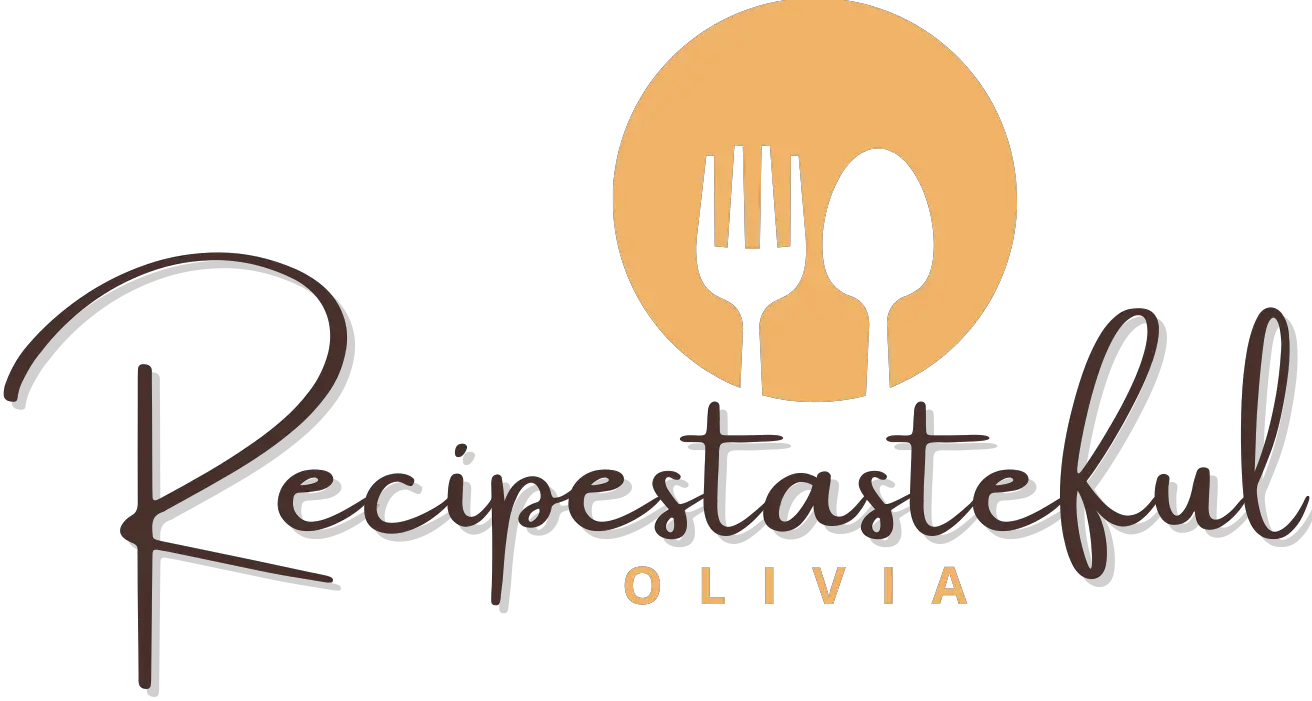




What I really liked is how easy this was to follow. Even for someone who’s not super tech-savvy, it made perfect sense.